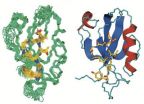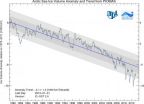(Press-News.org) PROVIDENCE, R.I. [Brown University] — In a new study in mice, a scientific collaboration centered at Brown University lays out in unprecedented detail a neurological signaling breakdown in Angelman syndrome, a disorder that affects thousands of children each year, characterized by developmental delay, seizures, and other problems. With the new understanding, the team demonstrated how a synthesized, peptide-like compound called CN2097 works to restore neural functions impaired by the disease.
"I think we are really beginning to understand what's going wrong. That's what's very exciting," said John Marshall, professor of medical science in the Department of Molecular Pharmacology, Physiology, and Biotechnology and the senior author of the study in the journal PLOS Biology. However Marshall did caution that it is too early to predict how soon a clinical therapy might arise from the results.
In mice and people, Angelman syndrome arises from flaws in a gene called Ube3A. When it functions properly, the gene limits the amount of a protein called Arc in the brain. Left unchecked by the disease, Arc impairs the development of synapses in the hippocampus. Those neural connections may be essential for proper learning and memory function.
In the new study, Marshall and his colleagues report a series of experiments that show how the abundance of Arc creates such negative effects and how Arc might possibly be defeated and its ill-effects repaired in the lab.
Essentially, Arc interferes with the operation of a synaptic protein called PSD-95, that is required for the actions of a growth factor, known as brain-derived neurotrophic factor (BDNF). This growth factor is released at synaptic contacts and initiates a sequence of molecular interactions necessary for the strengthening of neuronal connections or synapses. In mice with the flawed Ube3A gene, the signals sent by BDNF for memory formation are disrupted.
A team with a history
Although the researchers were surprised by the details they discovered about how Arc hinders the signaling process, they didn't come to the insight with complete naivete.
In other work, Marshall had been studying CN2097, designed by co-author Mark Spaller of Dartmouth College (Spaller synthesized it during earlier tenures at Wayne State University and Brown). The compound, which binds to PSD-95 was predicted to protect neurons under conditions of stroke and in disease states such as multiple sclerosis. With co-senior author Dennis Goebel of Wayne State, Marshall and Spaller found this to be the case. During the course of those studies the Marshall group learned that CN2097 enhanced the action of brain-derived neurotrophic factor (BDNF) which is known to be critically involved in long-term potentiation (LTP), a phenomenon believed by many neuroscientists to underlie learning.
Then, when University of North Carolina professor and former Brown postdoc Ben Philpot, now a leading expert on Angelman syndrome, returned to campus in 2008 to speak about Angelman syndrome, he showed how LTP is notably lacking in mice with the condition. After discussions with Philpot, Marshall and his group decided to test whether CN2097 might restore LTP in Angelman mice.
Early on, Marshall said, the team figured the defect in LTP in Angelman mice effect had to do with BDNF signaling.
"We started studying BDNF signaling in the Angelman syndrome mouse and discovered the signaling was defective, so that really was the breakthrough," he said. "It was completely unexpected. It's a new way of thinking about this disease."
That led to the set of experiments now reported in PLOS Biology, in which the group found that CN2097 essentially protects PSD-95 from interference by Arc, helping to restore BDNF signaling and the formation of stronger synapses. In electrophysiological tests on hippocampal tissue of healthy and Angelman mice, the compound made obtaining LTP significantly easier, although observing LTP in Angelman mice is still more difficult than in normal mice, Marshall said.
Paths to a therapy
Although the bottom line of the study is that the scientists now have taken a step toward understanding what seems to be going wrong in Angelman syndrome, the path toward a therapy for people is not so simple, Marshall said. For one thing, the team hasn't yet shown that mice benefit cognitively or behaviorally from CN2097's ability to protect PSD-95 from Arc and therefore to restore BDNF signaling and synapse formation.
"Can we actually rescue learning deficits?" Marshall said. "That would be the next stage to test. We haven't gotten that far yet."
Also, CN2097 breaks down in a matter of hours, so it may have to be administered quite frequently to sustain its beneficial effects.
But the research is extremely encouraging, Marshall said, because it pinpoints a potentially successful therapeutic strategy. Now scientists have two promising options. One is simply to keep testing CN2097 to determine whether it benefits live, behaving mice and what the best dosing regimen would be. The other is for scientists to take all that they have learned over the course of their experiments and use that knowledge to identify other compounds that might work like CN2097, but do so for longer periods of time.
"We think we are on the right track," Marshall said. "The goal is to try to help these kids. We want to do that as rapidly as possible."
Marshall has launched a new start-up company, Angelus Therapeutics, in hopes of raising the money required to perform more preclinical studies in animals. Further tests of the compound are necessary to lay the groundwork for possible future clinical trials.
Farther into the future, he added, the team can also look at other brain disorders that might also have to do with BDNF, synapse formation, learning, and memory, perhaps including Alzheimer's disease.
INFORMATION:
In addition to Marshall, Spaller, and Goebel, other authors are Cong Cao, Mengia Rioult-Pedotti and Crystal Yu at Brown; Paolo Migani at the University Pollitechnica delle Marche in Ancona, Italy; and Rakesh Tiwari and Keykavous Parang at the University of Rhode Island.
The Angelman Syndrome Foundation, the Rhode Island Science and Technology Advisory Council, and the National Institutes of Health (Grant R21-NS061176) supported the research.
Study in mice yields Angelman advance
Feb. 15 is International Angelman Day
2013-02-13
ELSE PRESS RELEASES FROM THIS DATE:
A neural basis for benefits of meditation
2013-02-13
PROVIDENCE, R.I. [Brown University] — Why does training in mindfulness meditation help patients manage chronic pain and depression? In a newly published neurophysiological review, Brown University scientists propose that mindfulness practitioners gain enhanced control over sensory cortical alpha rhythms that help regulate how the brain processes and filters sensations, including pain, and memories such as depressive cognitions.
The proposal, based on published experimental results and a validated computer simulation of neural networks, derives its mechanistic framework ...
Wetland trees a significant overlooked source of methane, study finds
2013-02-13
Wetlands are a well-established and prolific source of atmospheric methane. Yet despite an abundance of seething swamps and flooded forests in the tropics, ground-based measurements of methane have fallen well short of the quantities detected in tropical air by satellites.
In 2011, Sunitha Pangala, a PhD student at The Open University, who is co-supervised by University of Bristol researcher Dr Ed Hornibrook, spent several weeks in a forested peat swamp in Borneo with colleague Sam Moore, assessing whether soil methane might be escaping to the atmosphere by an alternative ...
3 'Bigfoot' genomes sequenced in 5-year DNA study
2013-02-13
Dallas, Feb. 13--The multidisciplinary team of scientists, who on November 24, 2012 announced the results of their five-year long study of DNA samples from a novel hominin species, commonly known as "Bigfoot" or "Sasquatch," publishes their peer-reviewed findings today in the DeNovo Journal of Science (http://www.denovojournal.com). The study, which sequenced three whole Sasquatch nuclear genomes, shows that the legendary Sasquatch is extant in North America and is a human relative that arose approximately 13,000 years ago and is hypothesized to be a hybrid cross of modern ...
European satellite confirms UW numbers: Arctic Ocean is on thin ice
2013-02-13
The September 2012 record low in Arctic sea-ice extent was big news, but a missing piece of the puzzle was lurking below the ocean's surface. What volume of ice floats on Arctic waters? And how does that compare to previous summers? These are difficult but important questions, because how much ice actually remains suggests how vulnerable the ice pack will be to more warming.
New satellite observations confirm a University of Washington analysis that for the past three years has produced widely quoted estimates of Arctic sea-ice volume. Findings based on observations from ...
We're emotionally distant and that's just fine by me
2013-02-13
When it comes to having a lasting and fulfilling relationship, common wisdom says that feeling close to your romantic partner is paramount. But a new study finds that it's not how close you feel that matters most, it's whether you are as close as you want to be, even if that's really not close at all.
"Our study found that people who yearn for a more intimate partnership and people who crave more distance are equally at risk for having a problematic relationship," says the study's lead author, David M. Frost, PhD, of Columbia University's Mailman School of Public Health. ...
Video study shows which fish clean up coral reefs, showing importance of biodiversity
2013-02-13
Using underwater video cameras to record fish feeding on South Pacific coral reefs, scientists have found that herbivorous fish can be picky eaters – a trait that could spell trouble for endangered reef systems.
In a study done at the Fiji Islands, the researchers learned that just four species of herbivorous fish were primarily responsible for removing common and potentially harmful seaweeds on reefs – and that each type of seaweed is eaten by a different fish species. The research demonstrates that particular species, and certain mixes of species, are potentially critical ...
Penn vet team uncovers a pathway that stimulates bone growth
2013-02-13
PHILADELPHIA — Researchers from the University of Pennsylvania School of Veterinary Medicine have discovered that a protein called Jagged-1 stimulates human stem cells to differentiate into bone-producing cells. This protein could help both human and animal patients heal from bone fractures faster and may form the basis of treatments for a rare metabolic condition called Alagille syndrome.
The study, published in the journal Stem Cells, was authored by three members of Penn Vet's departments of Clinical Studies-New Bolton Center and Animal Biology: postdoctoral researchers ...
FASEB joins President Obama in urging Congress to sustain investments in research and innovation
2013-02-13
FASEB also praised the President's emphasis on increasing investments in science and innovation. President Obama said, "Now is not the time to gut these job-creating investments in science and innovation. Now is the time to reach a level of research and development not seen since the height of the Space Race." In addition, the President noted that the automatic spending cuts known as sequestration would devastate priorities like education, energy, and medical research. "We will continue our advocacy efforts to urge Congress to sustain federal funding for the National Institutes ...
Opera's poisons and potions connect students with chemistry
2013-02-13
Opera audiences can feel the chemistry in romance-inspired classics like Mimi's aria from La Bohème, Cavaradossi's remembrance of his beloved while awaiting execution in Tosca and that young lady pining for her man with "O mio babbino caro" in the opera Gianni Schicchi. An article in ACS' Journal of Chemical Education, however, focuses on the real chemistry — of poisons and potions — that intertwines famous operatic plots.
João Paulo André points out that opera, in addition to being a form of theater, can be used as a teaching tool for chemistry students and the general ...
Advance promises to expand biological control of crop pests
2013-02-13
A new discovery promises to allow expanded use of a mainstay biological pest control method, which avoids the health, environmental and pest-resistance concerns of traditional insecticides, scientists are reporting. The advance toward broadening applicability of the so-called sterile insect technique (SIT) appears in the journal ACS Synthetic Biology.
Luke Alphey and colleagues explain that the Lepidoptera, a large family of insects with a caterpillar stage, cause widespread damage worldwide to cotton; apples, pears and other fruits; and vegetable crops like broccoli, ...
LAST 30 PRESS RELEASES:
This new understanding of T cell receptors may improve cancer immunotherapies
A new fossil face sheds light on early migrations of ancient human ancestor
A new immunotherapy approach could work for many types of cancer
A new way to diagnose deadly lung infections and save lives
40 percent of MRI signals do not correspond to actual brain activity
How brain-inspired algorithms could drive down AI energy costs
Gum disease may be linked to plaque buildup in arteries, higher risk of major CVD events
Contrails are a major driver of aviation’s climate impact
Structure of dopamine-releasing neurons relates to the type of circuits they form for smell-processing
Reducing social isolation protects the brain in later life
Keeping the heart healthy increases longevity even after cancer
Young adults commonly mix cannabis with nicotine and tobacco
Comprehensive review illuminates tau protein's dual nature in brain health, disease, and emerging psychiatric connections
Book prepares K-12 leaders for the next public health crisis
Storms in the Southern Ocean mitigates global warming
Seals on the move: Research reveals key data for offshore development and international ecology
Sports injuries sustained during your period might be more severe
World's first successful 2 Tbit/s free-space optical communication using small optical terminals mountable on satellites and HAPS
Can intimate relationships affect your heart? New study says ‘yes’
Scalable and healable gradient textiles for multi‑scenario radiative cooling via bicomponent blow spinning
Research shows informed traders never let a good climate crisis go to waste
Intelligent XGBoost framework enhances asphalt pavement skid resistance assessment
Dual-function biomaterials for postoperative osteosarcoma: Tumor suppression and bone regeneration
New framework reveals where transport emissions concentrate in Singapore
NTP-enhanced lattice oxygen activation in Ce-Co catalysts for low-temperature soot combustion
Synergistic interface engineering in Cu-Zn-Ce catalysts for efficient CO2 hydrogenation to methanol
COVID-19 leaves a lasting mark on the human brain
Scientists use ultrasound to soften and treat cancer tumors without damaging healthy tissue
Community swimming program for Black youth boosts skills, sense of belonging, study finds
Specific depressive symptoms in midlife linked to increased dementia risk
[Press-News.org] Study in mice yields Angelman advanceFeb. 15 is International Angelman Day



